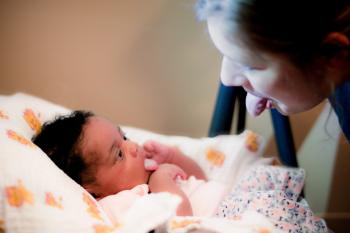Since the 1970s, studies have suggested that infants can imitate facial gestures, finger movements, and other actions just hours after birth. University of Miami Assistant Professor Elizabeth Simpson studies this phenomenon, known as neonatal imitation, in babies from birth to one year of life in her Social Cognition Lab in the Department of Psychology’s Child Division.
Recently, Simpson, whose research focuses on how infants begin to understand their social world, was awarded a $675,000 grant from the National Science Foundation to continue her research, specifically on neonatal imitation as a marker of healthy social development in human babies. Her studies on human infant imitation are based on her previous studies on monkeys, which showed that infant monkeys that were better imitators during their first week of life grew to be more social, engaged in more play behavior, and initiated more positive social interactions.
 |
| Research on baby imitation conducted in Simpson's lab. (photo credit: My Nguyen) |
However, the authors of a 2016 study published in the journal Current Biology,concluded that human babies don’t actually imitate. Their study asserted that dozens of previous studies on the subject, including Simpson’s research, is erroneous. But in a counter-response recently published in the journal Developmental Science, Simpson and her co-authors argue that the Current Biologystudy failed to use appropriate methods, and is highly flawed. She argues that there is overwhelming evidence that infant imitation is real.
“Our paper is a response to this misleading study that claimed to find no evidence of imitation in newborns,” Simpson says. “Unfortunately, there was a lot of media attention given to this poorly designed study, and our reply basically says that the study is flawed and our reanalysis of their data reveals positive evidence of neonatal imitation.”
Reviewing the data from the Current Biology study, Simpson and her co-authors said they found that the researchers used a flawed methodology that was destined to reach an erroneous conclusion. Among the errors, she notes, is how researchers presented babies with actions they are incapable of imitating, such as clicking their tongues and making specific sounds.
“Why would you expect a newborn baby to imitate a tongue click? In essence, they used a lot of different actions that are unfair because babies can’t yet do those things,” says Simpson.
The researchers, Simpsons notes, also showed the babies 11 different consecutive actions, each one for 30 seconds, before moving to another action and then another. “Even older children, even adults, would be unable to imitate 11 different actions in a row,” says Simpson. “That’s a lot for a newborn baby to process and, with only 30 seconds per action, they didn’t give the babies very much time to imitate the action.”
Simpson hopes her counter-response to the Current Biology study encourages other researchers who are interested in the field of developmental psychology and neonatal imitation to study the phenomenon.
“I am very invested in this line of research,” says Simpson, “because previous monkey studies show that imitation predicts the development of healthy social interactions. We need to study whether the same may be true in humans. But these researchers say the phenomenon itself is not real, when, in fact, there is growing evidence that it is. I’m afraid people won’t study the phenomenon if they take this study as the last word.”
Simpson’s reply, “Re-examination of Oostenbroek et al. (2016): evidence for neonatal imitation of tongue protrusion,” is published in the journal Developmental Science.
November 16, 2017

